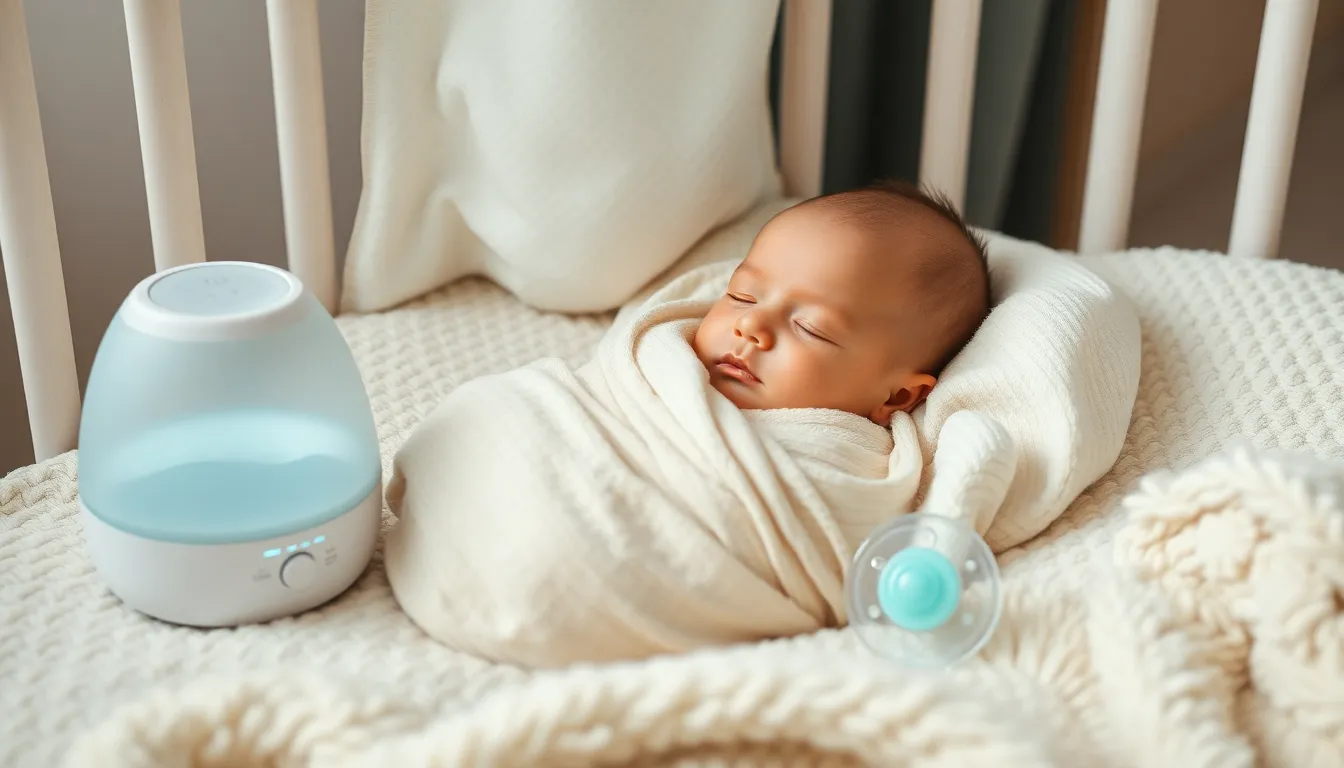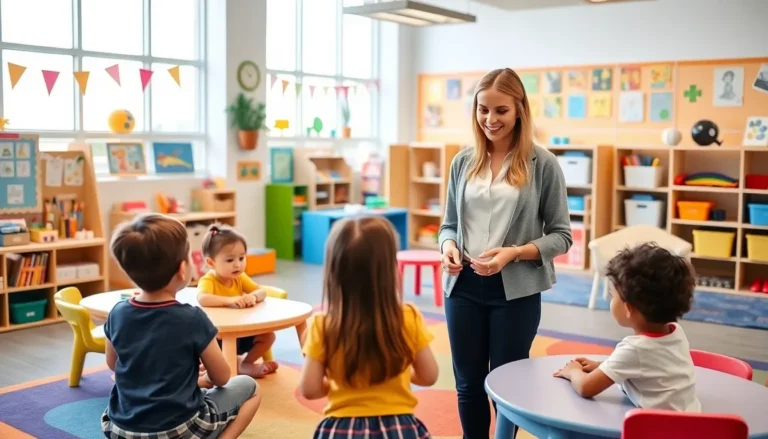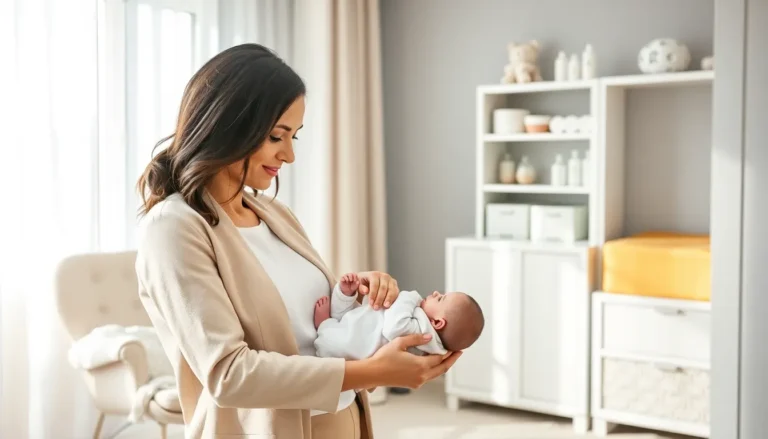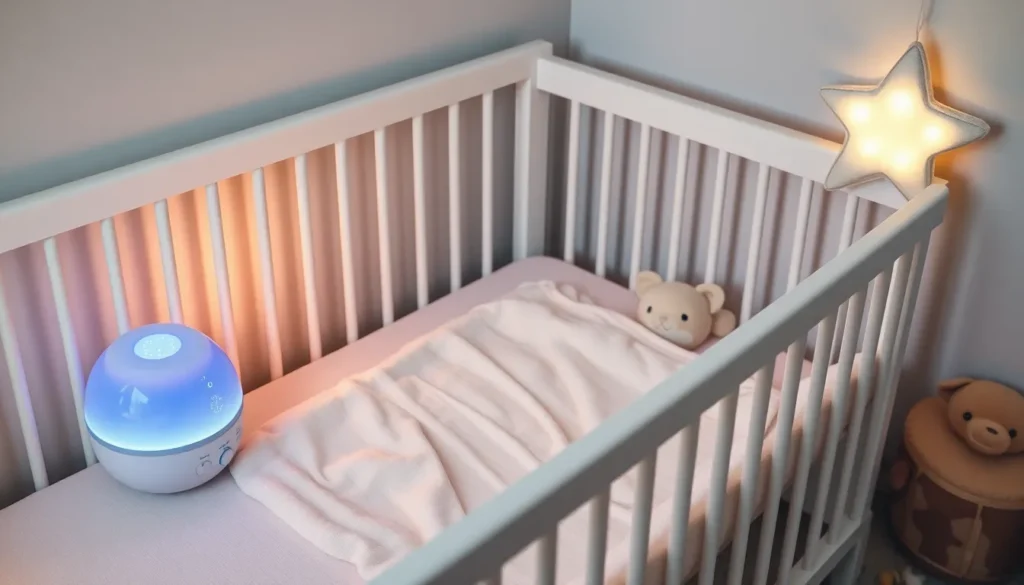Table of Contents
ToggleGetting a baby to sleep can feel like an uphill battle for many parents. With sleepless nights and endless soothing attempts, it’s no wonder they seek effective solutions. Baby sleep aids have become increasingly popular, offering a range of options to help little ones drift off peacefully.
From gentle sound machines to cozy swaddles, these aids cater to various needs and preferences. Understanding the right tools can make a significant difference in establishing a healthy sleep routine. As parents navigate the world of baby sleep aids, it’s essential to explore what works best for their unique situation.
Overview of Baby Sleep Aids
Baby sleep aids are tools designed to help infants fall asleep and stay asleep. These aids range from sound machines to swaddles, addressing various sleep challenges.
What Are Baby Sleep Aids?
Baby sleep aids include products that promote better sleep through various mechanisms. Common examples are:
- Sound Machines: These devices create soothing white noise or lullabies, masking disruptive sounds.
- Swaddles: Soft fabric wraps reduce startle reflexes, fostering a sense of security.
- Sleep Sacks: These wearable blankets provide warmth and comfort without the risks of loose bedding.
- Night Lights: Gentle illumination helps ease nighttime awakenings without overstimulation.
These aids support developing healthy sleep habits in infants.
Importance of Sleep for Babies
Sleep plays a crucial role in an infant’s growth and development. Key benefits include:
- Physical Growth: Sleep stimulates the production of growth hormones, aiding physical development.
- Cognitive Development: Adequate sleep enhances brain activity, supporting memory and learning.
- Emotional Regulation: Consistent sleep patterns promote better mood stability in infants.
- Immune Function: Sufficient sleep boosts the immune system, helping babies ward off illness.
Ensuring babies get adequate rest is vital for their overall well-being and future health.
Types of Baby Sleep Aids

Various baby sleep aids exist to assist infants in achieving restful sleep. Each type serves a unique purpose, addressing common sleep issues faced by parents.
White Noise Machines
White noise machines create a consistent sound environment that helps mask other noises, promoting better sleep. These devices produce gentle sounds, such as ocean waves or rainfall, which can soothe babies and aid in falling asleep. Research shows that white noise can reduce sleep latency by approximately 40%, making it a popular choice for parents seeking calm sleep environments.
Swaddles and Sleep Sacks
Swaddles and sleep sacks provide babies with a sense of security and warmth. Swaddles wrap infants snugly, mimicking the womb’s environment, which can reduce startle reflexes that disturb sleep. Sleep sacks serve a similar purpose but allow for greater freedom of movement while still keeping babies cozy. Studies indicate that utilizing swaddles can improve sleep duration by an average of 1.5 hours each night.
Pacifiers
Pacifiers can serve dual purposes by providing comfort and reducing the risk of sudden infant death syndrome (SIDS) during sleep. Research indicates that pacifier use at sleep times lowers SIDS risk by approximately 50%. Additionally, sucking on a pacifier can help soothe babies who may struggle with self-soothing techniques, making it an effective sleep aid during the night.
Benefits of Using Baby Sleep Aids
Baby sleep aids offer various advantages that enhance sleep quality and assist in establishing consistent sleep routines.
Improved Sleep Quality
Baby sleep aids contribute to improved sleep quality by creating a conducive sleep environment. White noise machines, for example, mask disruptive background noises, promoting longer and deeper sleep cycles. Research shows that using such devices can decrease sleep latency by as much as 40%. Swaddles and sleep sacks further enhance comfort by providing warmth and a sense of security, which can increase average sleep duration by up to 1.5 hours each night. Utilizing these aids leads to less nighttime waking and more restful sleep for infants.
Establishing Sleep Routines
Establishing sleep routines becomes more manageable with the use of baby sleep aids. Consistent application of aids like sound machines or dim lighting helps signal to infants when it’s time to sleep. This predictability fosters a comforting environment that encourages babies to adhere to regular sleep patterns. Research highlights that babies exposed to consistent sleep aids develop stronger sleep associations, leading to improved self-soothing skills. As a result, parents find it easier to create and maintain effective sleep schedules for their children, contributing to better overall sleep hygiene.
Considerations When Choosing Baby Sleep Aids
Selecting baby sleep aids involves critical considerations to ensure safety and effectiveness. Parents should evaluate safety guidelines and age appropriateness when making choices for their infants.
Safety Guidelines
Safety remains paramount when choosing baby sleep aids. Products must meet safety standards set by regulatory agencies such as the Consumer Product Safety Commission (CPSC). Parents should check for certifications, ensuring products are free from harmful materials and toxins. Selecting sleep aids with secure fittings is essential to avoid choking hazards. Additionally, avoiding items like traditional crib bumpers, which can pose suffocation risks, enhances infant safety. Regularly inspect baby sleep aids for wear and tear to maintain their integrity and safety standards.
Age Appropriateness
Age appropriateness plays a vital role in selecting effective sleep aids. Newborns benefit from swaddles, which provide a snug environment that resembles the womb, promoting better sleep. As infants grow, transitioning to sleep sacks introduces a safer, blanket-free alternative. Sound machines suit various ages, with gentle sounds fostering sleep for infants and older babies alike. While pacifiers are suitable for infants, their prolonged use should be monitored to avoid dental issues. Always consult pediatric guidelines for recommendations on specific sleep aids suitable for different age stages.
Finding the right baby sleep aid can significantly impact an infant’s sleep quality and overall well-being. With various options available parents can choose tools that best suit their child’s needs. Prioritizing safety and age appropriateness remains crucial in this selection process.
By creating a comforting sleep environment and establishing consistent routines parents can help their babies develop healthy sleep habits. Ultimately the right sleep aids not only support infants in achieving restful sleep but also contribute to their growth and development. Embracing these aids can lead to happier and healthier babies and more restful nights for the entire family.







